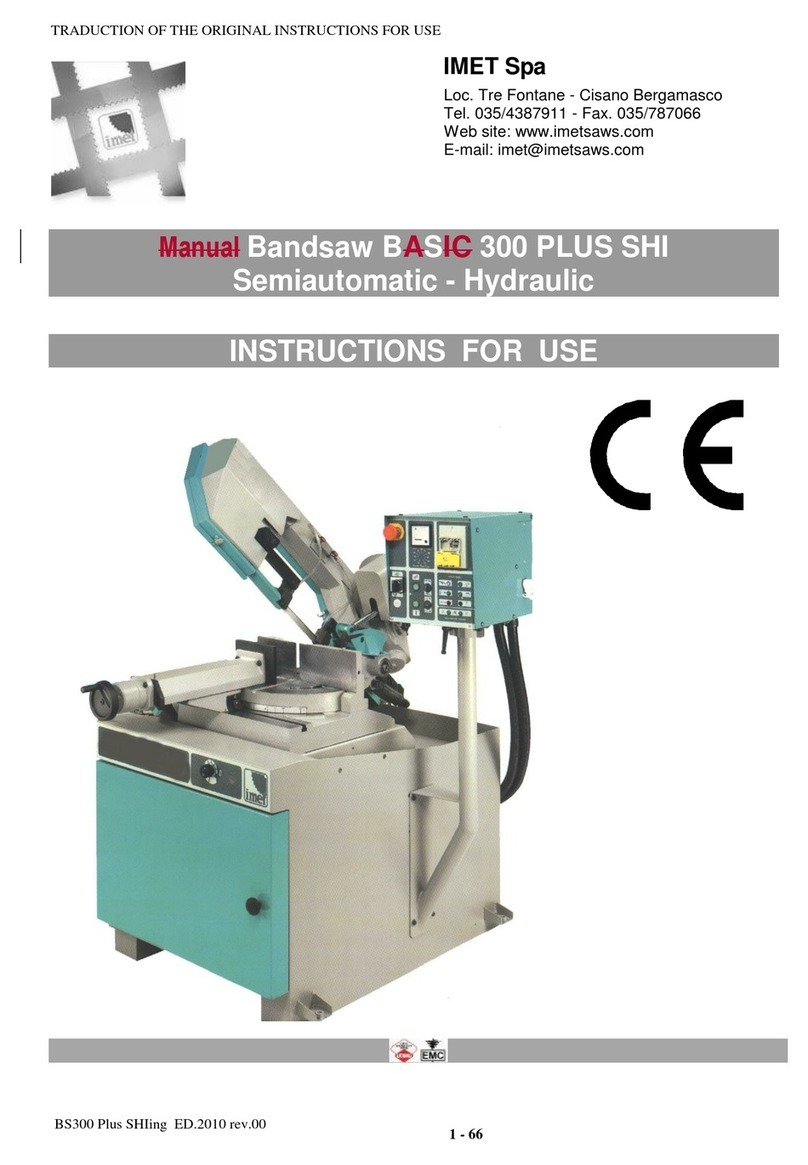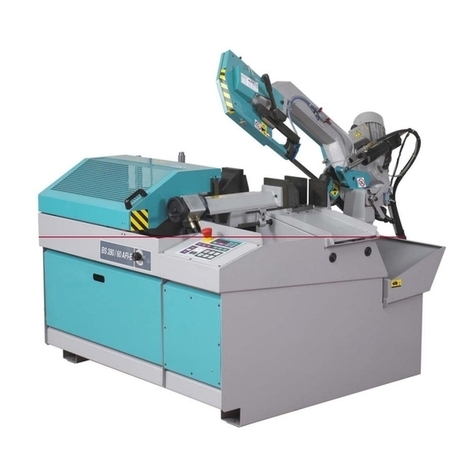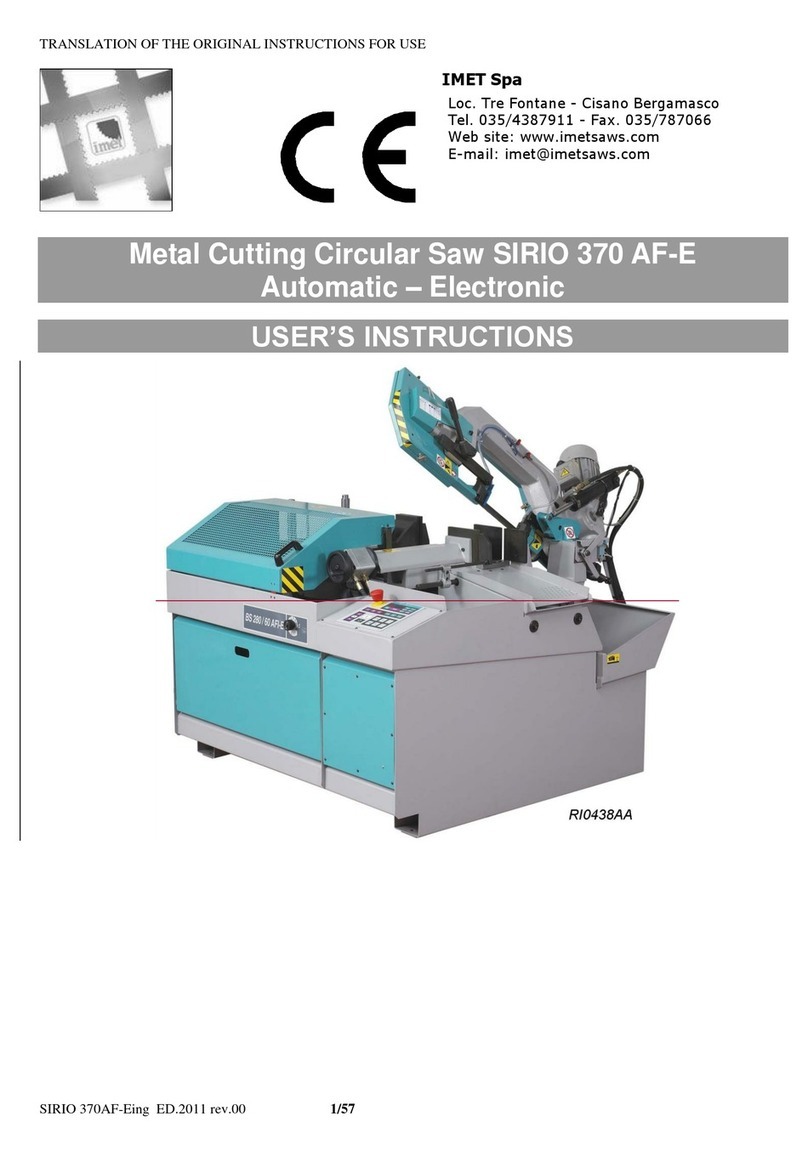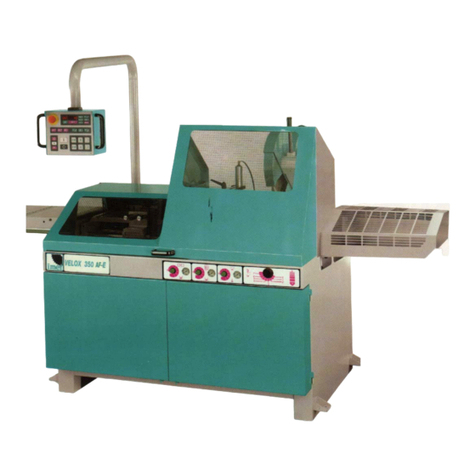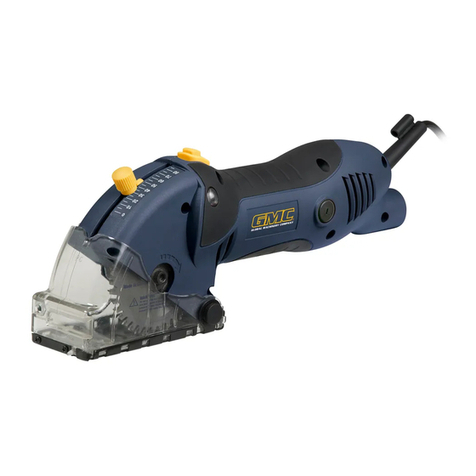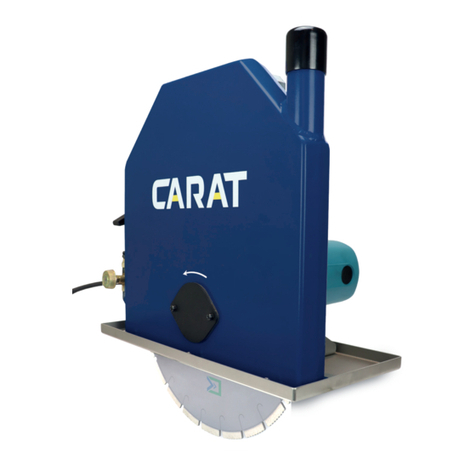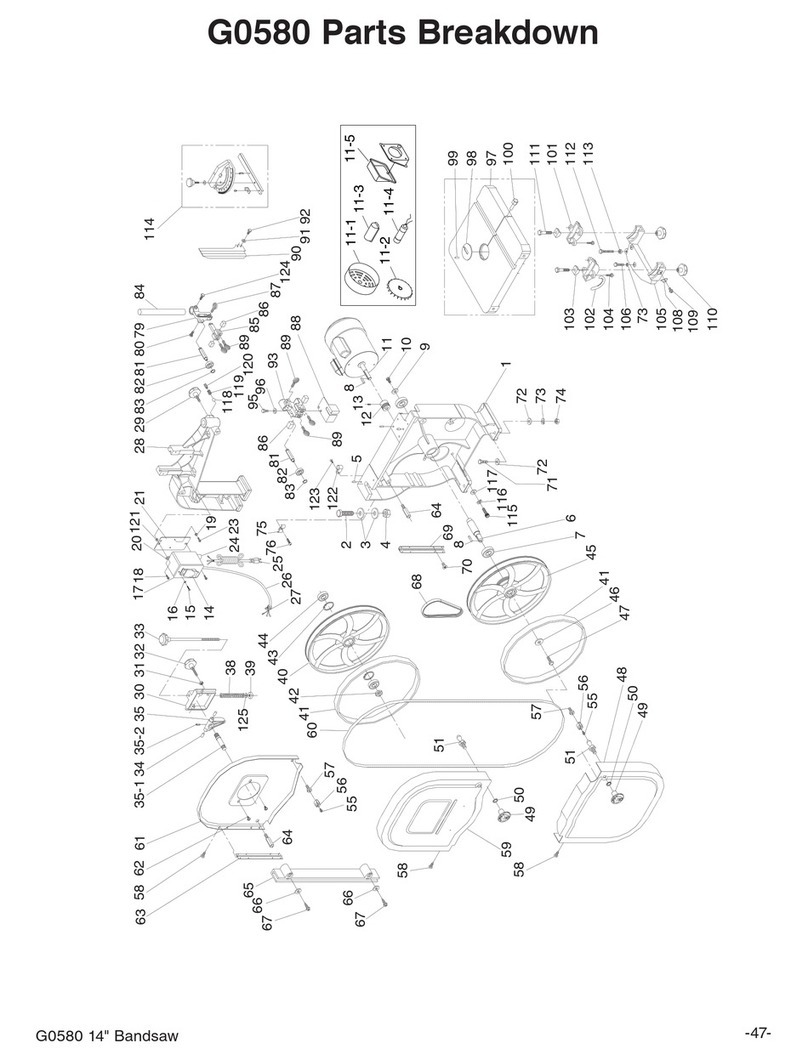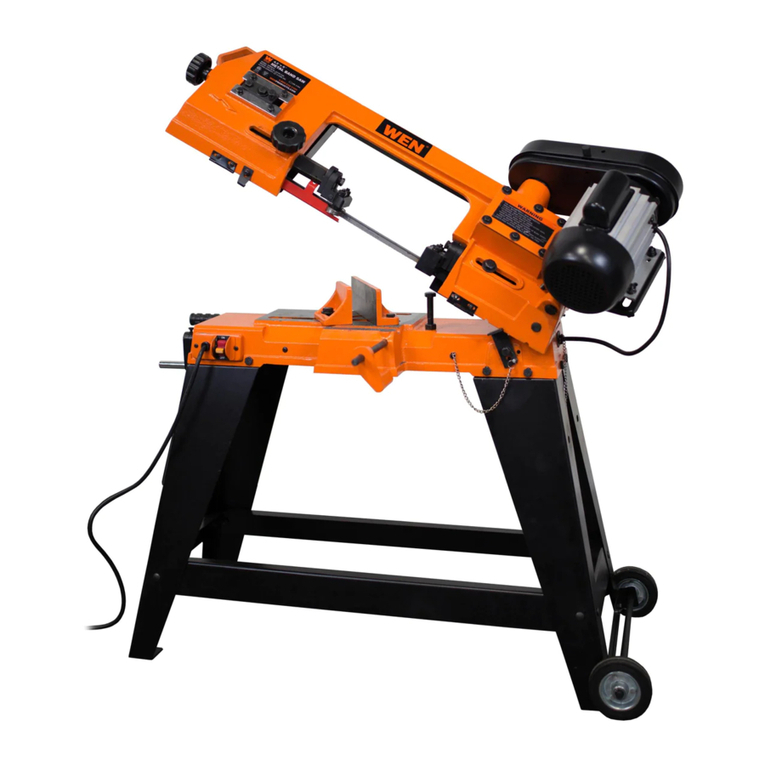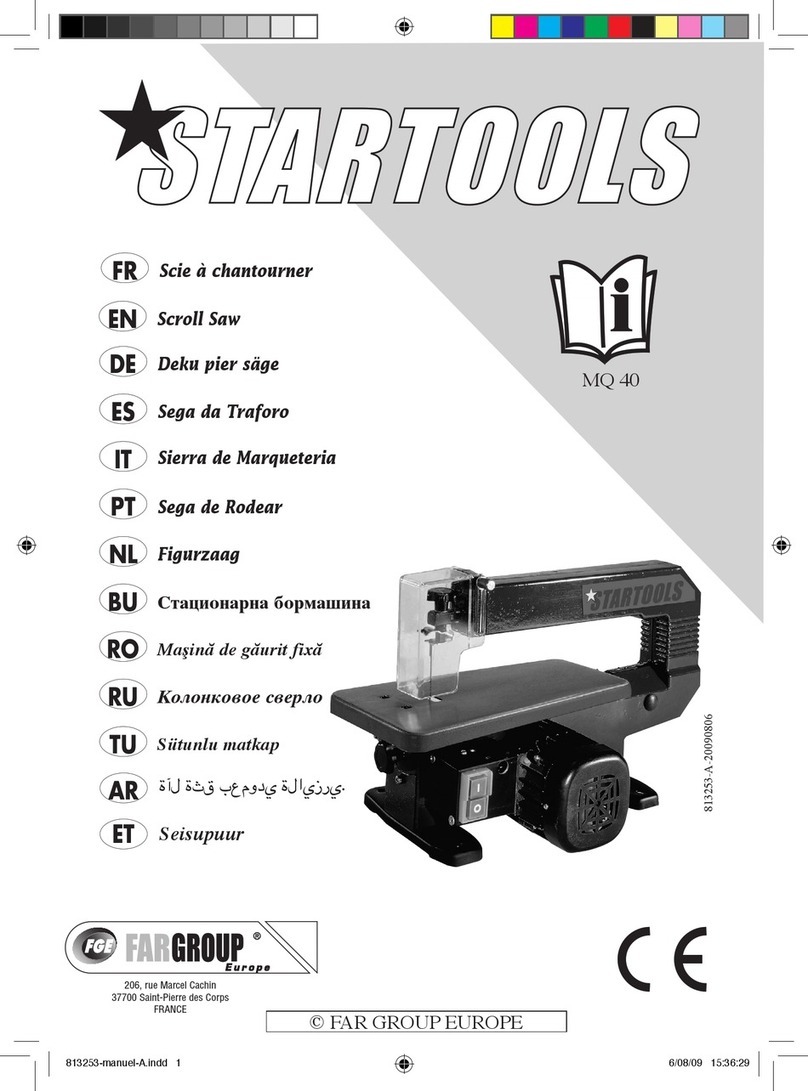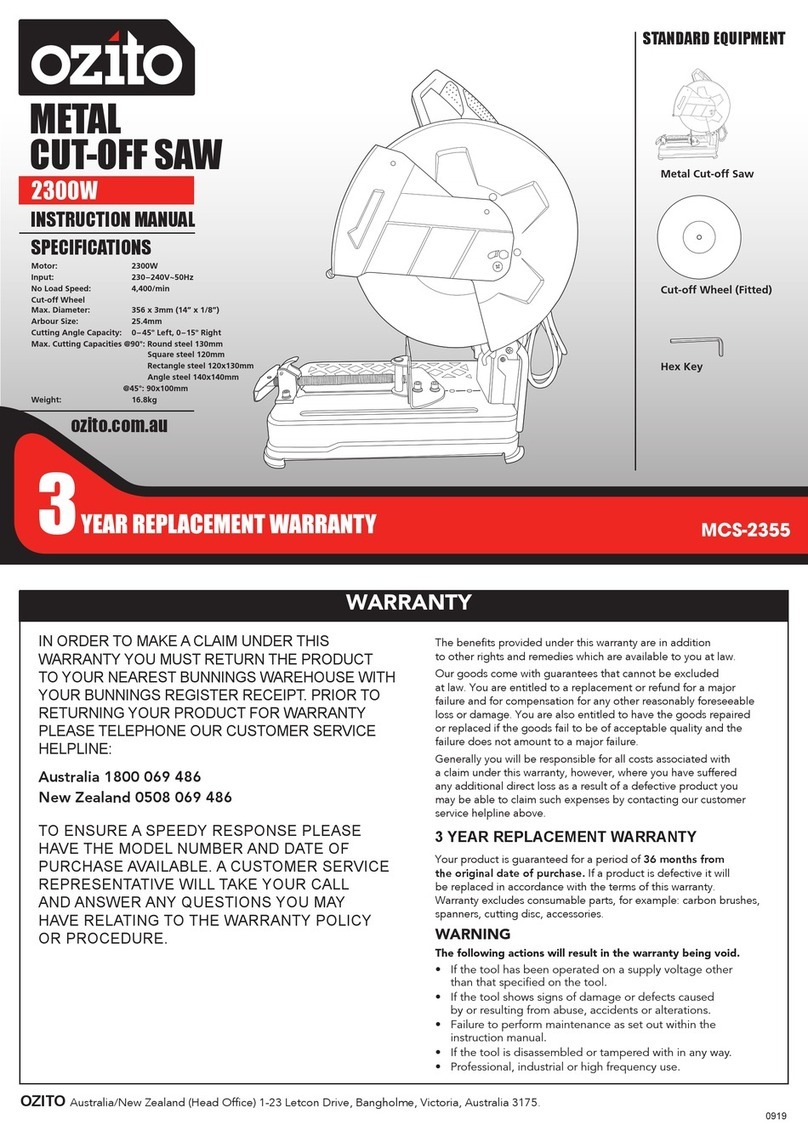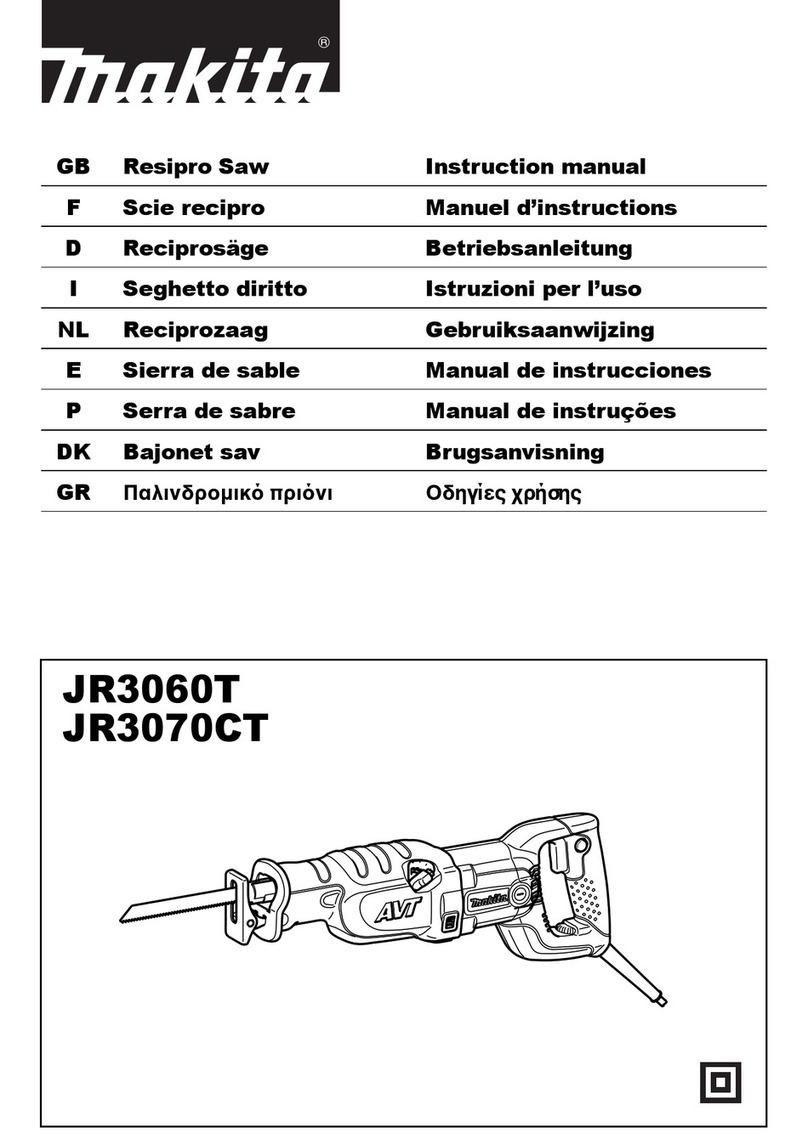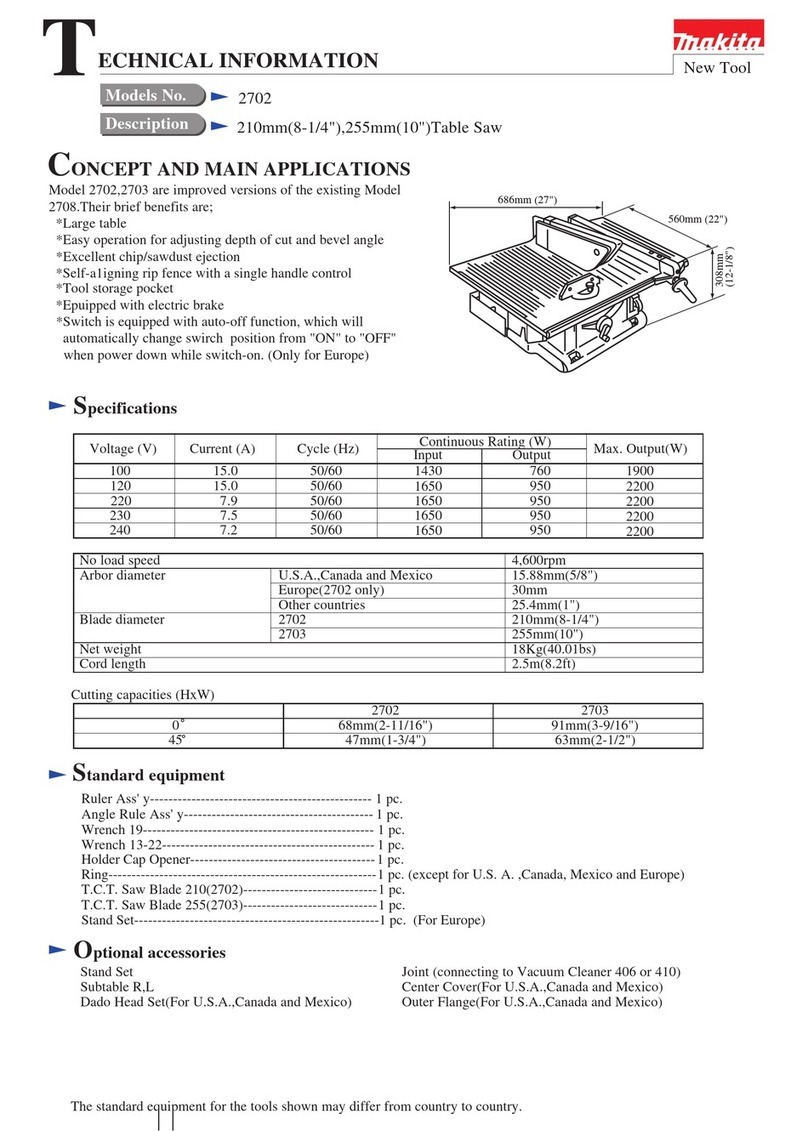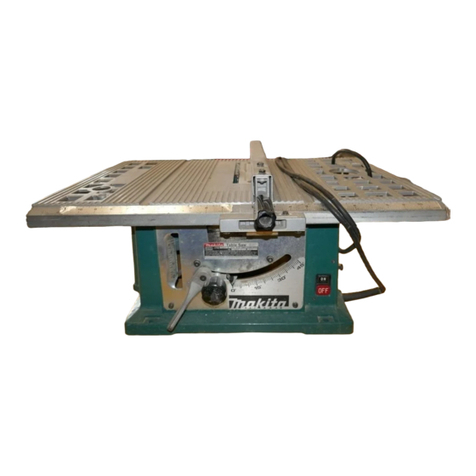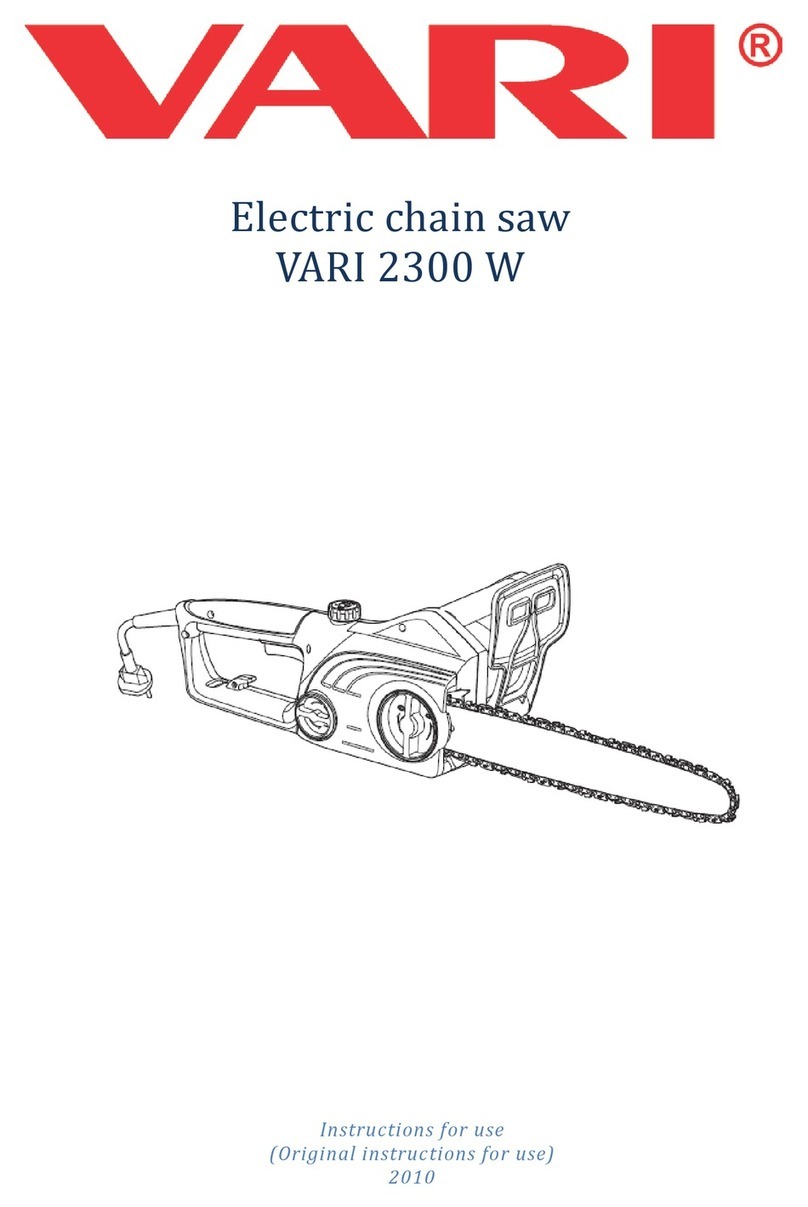IMET Spa BS300/60 AFI-NC User manual

TRADUCTION OF THE ORIGINAL INSTRUCTIONS FOR USE
BS 300/60 AFI-NC ED.2010 rev.00
1/59
IMET Spa
Loc. Tre Fontane - Cisano Bergamasco
Tel. 035/4387911 - Fax. 035/787066
Web site: www.imetsaws.com
E-mail: imet@imetsaws.com
Automatic, hydraulic bandsaw BS300/60 AFI-NC
with Numeric Control
USER’S INSTRUCTIONS

ISTRUZIONI PER L’USO-
BS 300/60 AFI-NC ED.2010 rev.00
2/59
280AFIE.DOC
63AD N. RIF. MI/D/04-01/0
----------------------------------------------------------------------------------------------------------------------------------------------------
ISTRUZIONI PER L'USO, MANUTENZIONE E RICAMBI
(leggere le avvertenze contenute nel presente libretto)
----------------------------------------------------------------------------------------------------------------------------------------------------
SEGATRICE A NASTRO PER METALLI
MODELLO : BS 280/60 : AFI-E (automatica idraulica elettronica)
(riepilogo indicazioni previste per la marcatura: vedi pag.3)
----------------------------------------------------------------------------------------------------------------------------------------------------
IMET spa Localita' Tre Fontane 24034 CISANO BERGAMASCO - BG-
Tel.035/787833 Fax 035/787066 WWW.IMETSAWS.COM -E.mail IMET@IMETSAWS.COM
We recommend to read carefully the information here included in order to install, use and maintain correctly and safely
this machine.
Please refer always to this instruction manual in case of assistance service need and keep it carefully for all the machine
life. The reference number is shown on the cover.
A consequence of the continuous improvement of the product is that some images/descriptions here included could not
correspond to the improved features of the machines.
Your kind collaboration would help us in intervening asap.
In the enclosed Compliance Declaration you will find the Safety and Reference Norms applied during the planning and
construction of this machine.
The choice and the use of the parts have been made by considering the conditions of use and the long machine life.
The identification plate, with the serial number, is fixed on the front right angle of the base or on a side of control box.
1.1 - ATTACHED DOCUMENT FOR E.M.C. ( INDUSTRIAL ENVIRONMENT)
The user is responsible for installation and use of this machine in compliance with the manufacturer's instructions shown
in this manual. This equipment meets the protection requirements in accordance with the Directives 2006/42/EEC,
2004/108/EEC as for Electromagnetic Compatibility (EMC). In particular, it follows the technical guidelines of the
Directives EN55011, EN50082-2 and it has been made for industrial and not for household use.
In the event of electromagnetic interferences the user is responsible for solving the problem with the help of the technical
assistance by the manufacturer. Before installing the machine the user must take into account possible electromagnetic
problems of the working area. In particular, we suggest to install the machine away from:
-signalling, control and telephone cables;
-radio-television transmitters and receivers;
-computers or controlling and measuring instrument;
-safety and protection devices.
The electric supply cable must be kept as short as possible, without any twists.
Covers, doors and the frame must be suitably closed when the saw is operating.

ISTRUZIONI PER L’USO-
BS 300/60 AFI-NC ED.2010 rev.00
3/59
Under no circumstances the machine must be modified except for adjustments and changes specifically approved by the
manufacturer.
Follow the maintenance schedule.

ISTRUZIONI PER L’USO-
BS 300/60 AFI-NC ED.2010 rev.00
4/59
===========================================================================
CE DECLARATION OF CONFORMITY (encl. II A DIR 2006/42/CE) / 01
===========================================================================
THE MANUFACTURER : IMET S.p.A
Località Tre Fontane
24034 - CISANO BERGAMASCO –BG- ITALIA
HEREBY DECLARES THAT
in designing and manufacturing the machine described here below , we have considered the most important requirements
of safety and health dictated by the European Directives of the Machine Security. Remember that this declaration loses its
validity if machine is modified without our agreement.
Trade name BAND SAWING MACHINE FOR METALS
Code / Model / Type
Manufacturing year
Serial number
IT IS IN COMPLIANCE WITH THE DIRECTIVES
DIRECTIVE 2006/42/CE OF THE EUROPEAN PARLIAMENT AND OF THE COUNCIL OF THE
17TH/05/2006 REGARDING THE MACHINES AND THAT MODIFIES THE DIRECTIVE 95/16/CE;
DIRECTIVE 2004/10/CE OF THE EUROPEAN PARLIAMENT AND OF THE COUNCIL OF THE
15/12/04 REGARDING THE ELECTROMAGNETIC COMPATIBILITY -EMC-
DIRECTIVE 2006/95/CE OF THE EUROPEAN PARLIAMENT AND OF THE COUNCIL OF THE
12/12/06 REGARDING ELECTRICAL EQUIPMENT FOR USE OF LOW VOLTAGE -LVD-
HARMONIZED STANDARDS REFERENCE EN.12100-01; EN 55011, EN50082-2, EN 13898, EN 60204
LEGISLATIVE DECREE N.17 OF THE 27TH OF JANUARY 2010.
AND AUTHORIZING THE PERSON LISTED BELOW TO ISSUE THE TECHNICAL FILE.
Date : 01.01.2010
The signatory identification The manager
Angelo Meroni
--------------------------------------------------------------------------------------------------------------------------
…………………….
………………..
………………..

ISTRUZIONI PER L’USO-
BS 300/60 AFI-NC ED.2010 rev.00
5/59
File : Machine no. Delivery note no Dated
---------------------------------------------------------------------------------------------------------------------------

ISTRUZIONI PER L’USO-
BS 300/60 AFI-NC ED.2010 rev.00
6/59
3 - MACHINE NOISE
The noise level of the working area - given the conditions described below - is determined by the simultaneous working of
several parts of the machine in motion (according to the working cycle), in addition to the tool when cutting the material.
The noise level is detected in different moments, corresponding to different working phases. The proper device is placed
about 1 meter near the machine and about 1,60 m above the floor. The results of each test is in dBA and they are
the average of 3 tests made from the left side, opposite side and right side.
For any machines the working conditions are the following:
When idle, at the maximum blade speed: dBA 63
During the cut, at a suited blade speed, cutting solid steel (St12=≈C20, 80mm diameter): dBA 75
(tolerance ±2dB).
In the standard production the test is made on a machine like this, in compliance with E.C. safety norms 2006/42/EEC .
Using the saw in bad conditions or using wrong tools causes significant alterations of these tests and it jeopardizes the
health of the staff and the good results of the work. Usefull is the reference Guide 2002
The noise depends mostly on the cutting material, on its size and on the clamping. Considering that the above mentioned
decibels could be exceeded, we recommend the operator to use personal protections (headsets, plugs, and so on) when
working for a long time with high noise levels.
3.1 - ADDITIONAL HEALTH AND SAFETY REQUIREMENTS
The machines manually controlled by an operator during all work phases must comply to further health and safety
requirements as specified by article 2.2 of the Annexed I of the European Directive 89/392 and following integrations. In
particular, the level of the machine vibrations when working must be clearly specified in the instructions.
This machine does not produce vibrations higher than 2.5 m/s2
The measurement procedure is in compliance with the general norms applied to this type of machinery.
As in the previous paragraph, using the machine in unsuitable conditions or using the wrong tools can cause
changes affecting this value, causing a risk to the health of the working staff as well as the quality of the
production.
Vibrations produced during the cut may be amplified by the material, by its dimensions and its
positioning/clamping in the vice.

ISTRUZIONI PER L’USO-
BS 300/60 AFI-NC ED.2010 rev.00
7/59
4 - GUARANTEE NORMS
I.ME.T. offers a wide range of sawing machines and accessories, destined to who buys/uses them as part of a
commercial or professional activity.
The manufacturer grants that this product has been strongly controlled and that there are no defects in the used and
working materials for a period of 12 months from the date of the delivery note.
The Italian law D.L. n° 24 issued on 02/02/2002 and valid since 23/03/2002 (which carries out the European Directive
1999/44/CE) indicates different terms only for convenience products for private use.
If the user points out some defects to the manufacturer during the warranty time, the manufacturer will replace the
components that are considered faulty.
In case of reparation of the machine during the warranty time the shipment will be accepted only if the delivery is Free
Destiny (that is the freight costs are supported by the owner of the machine), and the return of the machine to the
customer is considered EX WORKS.
If the manufacturer is not able to replace a component within an acceptable time, both companies (manufacturer and
user) will reach an agreement to satisfy completely the needs of the user.
The a.m. warranty is not valid in case of accidental damages, or defects provoked by a wrong use or maintenance of the
machine, by variations made on the equipment, or by the use of the machine in a place not corresponding to the indicated
environmental specifications.
4.1 - The manufacturer does not offer further warranties, written or spoken, explicit or implicit of its products and does not
offer implicit warranties on suitability for particular uses not foreseen by the agreement or on chances of selling them.
The a.m. limitations and exclusions can also be not applicable in Countries, where there are no implicit limits of warranty
time on the products. Anyway each implicit warranty is limited to a time of 12 months from the date of the delivery note.
4.2 - The date of manufacture, which can be evinced from the serial number placed on the machine, is a necessary
reference for warranty, after-sale assistance and product identification.
Each modification of the products, especially the installation of safety devices, will relieve the manufacturer of any kind of
responsibility.
The parts most subject to rapid and continuous wear are not included in the warranty (for example: transmission belts,
gaskets, oil, blades, and so on).
For electrical, electronic and hydraulic equipments and for all other equipment having its own specifications (whereas the
name of the manufacturer is known), the manufacturer gives to the user the same warranty received by the primary
manufacturer of these parts.
4.3 - The components replaced during the assistance provided by the manufacturer have a warranty of 6 months from
the installation date indicated on the Technical Service paper, one copy of which is given to the owner.

ISTRUZIONI PER L’USO-
BS 300/60 AFI-NC ED.2010 rev.00
8/59
5 - INDEX Page
1- INTRODUCTION 2
2 –CONFORMITY DECLARATION 3
3 –MACHINE NOISE 4
4 –GUARANTEE NORMS 5
5 –Index 6
6 –Technical characteristics 7
7 –Installation –minimum requirements 9
8 –Moving and transit 9
9 –Fittings/Accessories 11
10 –Blade choice 12
11 –Instructions for use and warnings 14
12 –Machine description 17
13 –Machine Set-up 18
14 –Blade tension 19
15 –Drivers Description 20
16 –Adjustments 25
17 –Maintenance –for the user 27
18 –Blade run-in 28
19 –Machine run-in 28
20 –Draining of used/produced substances 29
21 –Trouble-shooting 29
22 –Machine demolition 31
23 –Spare parts 32
24 –Maintenance –for skilled personnel 33
Electrical drawings
Hydraulic diagram
Spare Parts drawings

ISTRUZIONI PER L’USO-
BS 300/60 AFI-NC ED.2010 rev.00
9/59
6 –TECHNICAL DETAILS
Automatic electronic bandsaw with numeric control and hydraulic working , suitable for cutting metal profiles and solids
from 0 to 45 deg. left in automatic cycle, from 0 to 60 deg. left in semiautomatic cycle. Material feeder equipped with
recirculating-ball screw and self-braking electric motor. In compliance with E.C. - CSA - UL Safety Norms and with the
Norms of Electromagnetic Compatibility (EMC).) The new control panel allows to set up and memorize up to 10
programs, each one with 10 programmable cutting lengths and number of cuts. The LOOP option allows to repeat several
times the same program, even when changing the material size.
STANDARD MODEL EQUIPPED WITH:
1.5 kw Three-phase motor, controlled by an Inverter - ESC - with blade speed from 18 to 110 m/min - electrical
components complying with E.C. Norm EN60204-1, EN55011, EN50082-2, low voltage (24V), main switch with
interlocking attachment and minimum tension coil, thermo-magnetic overload motor protections, emergency stop.
Easy-to-use CNC control; all operating functions of the machine are programmed on the control panel, mechanical device
which detects automatically the start-cut point (position sensor).
Working conditions, such as blade speed, piece counter and number of pieces to cut shown on an alphanumeric display,
memorization of the cutting lengths (from 4 to 30.000 mm) with automatic repetition of the strokes, working anomalies
shown as well
New blade guard which allows a quick and easy replacement of the blade with adjustment by means of a screw located on
the front side of the sawframe; microswitch.
Front fixed hydraulic vice, jaws height 130 mm –easy stop at 0° and 45° left for mitre cutting, graduated plate to identify
different angles, feeder that runs on recirculating-ball screws, 300 mm maximum opening, 4 mm minimum stroke, 210
mm minimum scrap-end, incremental advancement with automatic correction for the blade thickness. Feeder vices fitted
on a mobile plate, motion by means of chromed and hardened guides.
Connection for loading tables, unloading slide/adapter for unloading table - removable chip tank, coolant pump and
washing spray gun, hydraulic unit with oil. New band-cleaning device with brush, bi-metal band, wrenches and instructions
manual, maintenance and spare parts.
WIDE RANGE OF ACCESSORIES: Two pressure reducers for hydraulic vices with manometers, upper rollers to cut more
pieces side by side (max dimensions 280x100 mm, only for straight cut) , RTS = modular loading roller tables, 400 mm
wide and 2 m long.
If not otherwise indicated, all data reported in this manual refer to the standard version, suitable for working
at 400 V / 50 Hz THREEPHASE with NEUTRAL WIRE.
= cutting capacity ( max. dimension on PROFILES & TUBES)
= BLADE SIZE = WEIGHT =VICE OPENING
= motor choice and blade speed (at 50 Hz);
*
mm.
Kw
M/min
mm
Kg
mm
mm
mm
2765 +-10
X27X0,9
1,5
3~
18-110
300
680
255
230
300x180
210
190
210X100
135
110
130X100
* = If the device of MINIMAL LUBRICATION is mounted on the machine, the cutting capacity ON SQUARE is reduced by
around 10 mm due to the spray nozzles on the anterior band guide.

ISTRUZIONI PER L’USO-
BS 300/60 AFI-NC ED.2010 rev.00
10/59
Size
(mm)
B
width
L
depth
H
Height
H
worktable
When working
1800
1850
1880
870
Packed
1800
1750
1600
7 –INSTALLATION
This machine can work according to the parameters provided by the manufacturer if correctly installed and if the minimum
requirements are observed, as follows:
- It must be used indoor and with temperatures from +5 to + 40 ° C.
- The relative humidity of the environment must not be over 95%.
- The nominal value of the voltage must be between ±10% and the frequency must be between ±2% of the nominal
value.
The floor must have a proper loading capacity and be flat.
Floor space, operator position and working area are indicated in the included drawing that concerns only the bandsaw,
without optional accessories.
The worktable must be levelled by using the screws and nuts put in the little feet holes. The machine must be fixed to the
floor (it is especially necessary with connected sccessories).
The included electrical schemes reproduce the necessary details to arrange the connections, to be suited for a
5KW power request.
Earthing of all the electric parts with a dedicated GREEN/YELLOW wire, connected with a TN system to the
supply cable. A supplementary earthing point –indicated with PE –can be located on the metallic structure of the
machine.
At the origin of the power supply cables a device (such as fuses) to protect against overloading has to be
installed. On the models equipped with electronic variable-speed drive unit (ESC), in order to connect the
differential protection on the power supply line, switches with a threshold of interference on the power
dissipation of not less than 300 mA (size 0.3 A or higher is recommended) have to be employed, having possibly
time adjustment availability (0>1.5 sec).
E.M.C. - Electromagnetic noise
The user is responsible for installing and using this saw according to the manufacturer’s guidelines outlined in this manual.
This equipment complies with the protection requirements established by the Directives 89/336/CEE, 92/31/CEE,
93/68/CEE concerning Electromagnetic Compatibility (EMC). It is in compliance also with the technical guidelines of the
Norms EN 55011, EN 50082-2 and it is intended for industrial and not for household use.
Before installing the machine the user must take into account possible electromagnetic problems of the working area. In
particular we suggest to install the equipment away from:
- signalling, control and telephone cables;
- radio-television transmitters and receivers;
The supply cable has to be as short as possible, with no twists. All doors, coverings and frame have to be closed when the
saw is running. Do not make any modifications to the machine except for adjustments and replacements
allowed/recommended by the manufacturer. Follow the maintenance schedule.

ISTRUZIONI PER L’USO-
BS 300/60 AFI-NC ED.2010 rev.00
11/59
8 –MOVING AND TRANSIT
For the transport of the machine only the methods indicated below are possible. However, be sure that the means of
transport and lifting are able to stand the machine's weight and its packing (about 1000 Kg):
WARNING
The personnel in charge of loading, unloading and moving the machines should use protective gloves.
WARNING
When lifting or moving the machine, or a part of it, take care of clearing the operations area of the people, considering
also an appropriate safety area around it, so as to avoid any risks of injuring people or damaging things located nearly.
Special packing –wooden crate , wooden case –may be predisposed on request, by charge.
ALL THE OPERATIONS THAT INVOLVE MOVING THE MACHINE MUST BE CONDUCTED WHILE RESPECTING
THE FOLLOWING BASIC RULES:
+ When moving the machine, an appropriate means has to be used, with a loading capacity higher than the weight to
lift, which is indicated on the machine.
+ When choosing and then using equipment such as ropes, chains or lifting belts, be careful about their geometry
during the lifting and about the consequent actual loading capacity.
+ The machine is structured so as to offer lifting points, which are appropriately indicated and will have to be used for
lifting it.
+ In case the lifting belts touch parts of the machine, nylon belts are required; ropes or chains wrapped with jute or
clean covering can also be used. A great care is necessary while slinging and moving the machine in order to hinder
damages.
+ All operations have to be conducted gradually, so as to avoid jolts and dangerous situations.
+ The person in charge of the operations has to make sure that all the national, local and company norms in reference
to injury prevention and work safety are respected.
+ One or more areas for material storage have to be identified.
Transport with machine at sight
This type of transport is usually chosen for deliveries by truck, in case of short trips. The machine is wrapped with
thermoplastic material in order to assure a suited protection of all its parts; the machine is then loaded on a truck and
should be wrapped with ropes that tie it up. To lift it, use a forklift from the front side of the machine, with forks length 1.5
m or more.
Warning: if the machine is loaded on open trucks, please cover them !
Transport with wooden crate or wooden case. ( ON REQUEST , WITH SURCHARGE )

ISTRUZIONI PER L’USO-
BS 300/60 AFI-NC ED.2010 rev.00
12/59
The saw is wrapped with thermoplastic material in order to assure a suited protection of all its parts; then it is packed into
a wooden crate or cage to protect it from collisions, inclement weather and so on. To lift it, use a forklift from front side of
machine.
The machine is fixed to the packing by means of screws, so as to hinder that it can move during the transport
If the saw has to be moved around after being unpacked, make sure the sawframe is all the way down and properly
blocked, and the feeder is as close as possible to the cutting area.
9 –FITTINGS / ACCESSORIES
The information necessary for the installation are given together with the fittings. Anyway you can find here following a
short description of the product.
Loading/Unloading Roller Tables –ON REQUEST - To install them correctly, it is necessary first of all to level and fix
the machine. They are comprised of modular steel sheets, 2 meter long.
To connect it to the machine -LOADING SIDE- it is necessary to take away the first roller from the roller support of the
machine, then connect directly the roller table by using the two holes where the roller was assembled before.
The unloading table –RIGHT SIDE –can be connected directly to the unloading slide thanks to the two lateral rollers and
2 screws.
The alignment of the loading/unloading tables must begin with the one closer to the machine, taking as reference point
the worktable and the back jaw.
When cutting long bars, fix the table to the floor and make sure the coolant, which is carried by the bars, doesn’t drop on
the floor.

ISTRUZIONI PER L’USO-
BS 300/60 AFI-NC ED.2010 rev.00
13/59
Vice pressure reducer - It allows to reduce the working pressure of the closing jaws compared to the general pressure of
the system. It is a modular unit and it can be assembled also later between valve-holder base and the hydraulic valve
(one for the valve of the main vice and one for the feeder vice); it doesn’t require any cable connections. By opening the
left side front door you can adjust the pressure.
Vertical rollers –they allow to clamp more bars together on the same row. They prevent the bars from lifting and from not
being properly clamped when the vice closes.
Hydraulic vertical vices for cutting bundles - RI0433 e RI0434 –connected to the standard vices, they allow to feed
and cut a bundle of bars; minimum length 110mm, max length 300mm, max height 120mm
Minimal lubrication system –This device, applied to the saw, allows to eliminate almost completely the traditional
coolant system, keeps the material much cleaner and avoids to waste cutting oil and water. It works only during the cut, it
is depending from air supply.
It is comprised of a nozzle - 1/RI0463 - with 3 micro-holes, a tank with devices to adjust the quantity of oil and the air
pressure. The switch of the electric system - 3/RI0462 - working with low tension 24V AC allows to turn it off at any
moment and use the normal coolant system. Remove the nozzle 1/RI0463 to obtain the maximal cutting capacity.

ISTRUZIONI PER L’USO-
BS 300/60 AFI-NC ED.2010 rev.00
14/59
Voltage transformer - place it between the electric supply of the premises and the electric supply of the machine. It
allows to work with a different voltage than the standard one (that is 400V / 50 Hz). Available voltages: 230V, 460V, 500V,
575V.
7 - BLADE CHOICE
In this paragraph we recommend the type of blade according to the material to cut. To get the best performance from this
machine it is necessary to understand how to use the tools and what you do not have to do with them. The blade for this
bandsaw must have the following size (mm) :
maximum length = 2770 minimum length = 2750 height = 27 thickness =0,9
The type of blade is also important, usually it’s a bi-metal blade with different HARDNESS, named M42 or SVGLB ( for
general purpose, tubes, profiles and solids, available in all pitch type), M51 or SHL (preferred for big solids of
hardening steel, INOX material too, available with 3/4 tooth pitch).
The durability of the teeth increases, and also the fragility, when going from the material M42 to M51.
To making a correct cut it’s essential to choose the pitch ( t ) or the number of the teeth per inch (z). Usually the
blade must have a pitch as follows :
- high pitch (small teeth), to cut thin materials, tubular and profiles.
- low pitch (big teeth), to cut solids or particular sections that require at times a big blade effort (for example, the central
part of a U profile), or softer materials as aluminium, copper, soft bronze.
By choosing the right one you can avoid a lot of working errors, get a good cut and the necessary room for the chips. If
you cut more bars at the same time, you must consider them as a single bar and consider the total size. The
following table provide the information for a correct choice, it can also be updated or modified by the user according
to his personal experiences.
Even if blades with constant pitch are available, most bandsaws allow to use blades with variable pitch - groups of teeth
with different pitch between them - which reduce vibrations and noise, improving the quality of the cut and the
performance.
SUGGESTED TOOTH PITCH
SOLIDS
Outside
Diameter
(mm)
BIG
PROFILES
Wall
Thickness
(mm)
PROFILES
Wall
Thickness
(mm)
BUNDLE
Length
to Cut
(mm)
VARIABLE
CONSTANT
14 M42
-
-
1,5 max
-
10/14 M42
10 M42
-
-
1 to 2
-
8/12 M42
8 M42
20 max
-
2 to 4
-
6/10 M42
6 M42
40 max
-
4 to 8
-
5/8 or 5/7 M42
5 M42
30 to 80
6 to 12
-
50 to 100
4/6 M42
4 M42
40 to 90
10 to 20
-
70 to 120
3 / 4 M42 or M51
3 M42 or M51
70 to 150
15 to 40
-
100 to 200
2/3 M42 or M51
2 M42 or M51
120 to 230
over 40
-
120 to280

ISTRUZIONI PER L’USO-
BS 300/60 AFI-NC ED.2010 rev.00
15/59
The following chart refers to the cut of a solid with diameter 80mm, using a standard bandsaw.
If the material size changes, the corresponding parameters change as well, according to the type of machine and
to the possible accessories which have been installed. For example, in case the material size increases, these
parameters have to be reduced, and vice versa.
MATERIAL
GROUP
i.e. DIN denomination
DIN N°
Maximum
BLADE
SPEED
m/min
Minimum
BLADE
SPEED
m/min
MOTOR
SPEED
(1or2)
FEED
FORCE
COOL
ratio
1)STRUCTURAL
STEEL
St37 St42
10037-10042
60
40
1.
LOW
10%.
St50 St60
10050-10060
50
35
1
LOW
10%
HARDENING STEEL
C10 C15
10301 10401
45
35
1
LOW
15%
16MnCr5 20CrMo5
17131
17264
40
30
1
Low/Med
10%
AUTOMATIC STEEL
9S20 10SPb28
10711
70
50
1 2
LOW
15%
BEARING STEEL
100Cr6
13505
40
25
1
Med/Hig
5%
SPRING
STEEL
65Si7
15028
40
30
1
Med/Hig
5%
2)TOOL STEEL
UNALLOYED
C80W1
C125W
11525
11663
40
30
(1)
HIGH
5%
ALLOYED
210Cr12 X155CrVMo
12080 12379
30
20
(1)
HIGH
dry
X40CrMoV51
12344
35
20
(1)
HIGH
5%
HIGH SPEED
STEEL
S-6-5-2-2
13243
30
20
(1)
HIGH
5%
INOX STEEL
X5CrNi18 X10Cr1810
14305
30
20
(1)
HIGH
5%
3)SPECIAL ALLOYS
NiCr19NbMo
(Inconel)
24668
20
15
--
HIGH
20%
NiMo30
(Hastelloy)
24810
20
15
--
HIGH
15%
NiCr13Mo6Ti3
(Nimonic)
24662
20
15
--
HIGH
15%
TITANIUM
Ti1
37025
30
20
(1)
HIGH
10%
G-TiAl6V4
37164
35
20
(1)
HIGH
10%
4)CAST IRON
GG15 GG30
--
50
30
1
Med/Low
dry
5)NOT-FERROUS
ALUMINIUM
AL99.5 GalSi15Mg
--
300
50
2
Med/Low
2%
BRONZE
CuSn6 CuSn6Zn
--
120
40
2 1
Med/Hig
2%
COPPER
G.Cu Ke.Cu
--
200
50
2
LOW
2%

ISTRUZIONI PER L’USO-
BS 300/60 AFI-NC ED.2010 rev.00
16/59
11. INSTRUCTIONS FOR USE AND WARNINGS
This bandsaw can carry out cutting cycles, at the end of which the material that has been cut has to be removed and if
necessary the cutting conditions have to be changed = SEMIAUTOMATIC CYCLES
It can also perform autonomous cutting cycles, including the feeding of the bar until it has been completely cut =
AUTOMATIC CYCLES
Thus the machine can be driven by the operator or carry out a cutting cycle automatically, which ends when the machine
stops. The starting procedure has to be repeated to begin a new one.
11.1 - This machine is designed and manufactured so as to be safely used by the operator, provided that it is
properly run. No protections will ever suffice if the operator does not work with caution, does not make sure that the
machine is in top working conditions and does not follow the instructions below.
Don’t forget that this bandsaw is designed to CUT METALS with a proper tool, and that you are responsible for a SAFE
and CORRECT use. You must :
1. check that the machine is properly installed and electric supply is suited.
2. be sure to learn all main features of the saw before running it.
3. do not expose yourself or any other people to any risk.
4. wear personal protective equipment
5. do not remove or modify the SAFETY DEVICES installed by the manufacturer, make sure that they are always in a
good condition, too.
6. follow a regular maintenance schedule and check regularly the efficiency of the saw.
7. never use tools with unsuited characteristics
8. do not try to cut material with a size bigger than the cutting capacity of the machine
9. Keep the cutting area clear of tools or other loose objects.
10. do not run the saw unless all guards and protections are in place
11. NEVER WEAR loose clothing, long sleeves, large gloves, jewellery, or any other items that may get entrapped into the
machine
12. Always disconnect the power supply when performing maintenance or making adjustments.
13. do not get close to the cutting area with your hands or any other part of your body when the saw is running
14. Clamp properly the material in the vice and never hold it with your hands
15. Support appropriately the bar from both sides to prevent it from falling
We recommend to install a roller table on the unloading side in case the cutting length of the bar is
bigger than the distance between the blade and the right side of the basement
16. When cutting very short pieces, make sure they do not jam into the blade.
17. If the blade remains entangled with the material, stop the machine, open the vice and remove the material, then check
the condition of the blade and the teeth: if they are damaged or broken, change the blade
18. Apply a constant pressure during the cut
19. Do not move the saw during the cut or cause instability
20. Wear personal safety equipment when running the machine
ALWAYS RUN THE SAW SAFELY, USING COMMON SENSE AND ALERTNESS

ISTRUZIONI PER L’USO-
BS 300/60 AFI-NC ED.2010 rev.00
17/59
.
On some parts of the machine there are some stickers which warn about the safety measures that have to be taken by the
operator who runs it. Their meaning (easy to understand) is explained in the following chart
11.2 - OPERATOR’S SAFETY

ISTRUZIONI PER L’USO-
BS 300/60 AFI-NC ED.2010 rev.00
18/59
This section illustrates the safety protections applied on the saw, according to the current legislation in the field of safety.
11.2.1. ELECTRIC EQUIPMENT –norm EN 60204-01
. Electric board closed with screws - general switch
. Marking of the electric components used, according to the indications on the electric scheme
. Control circuit with 24V tension –Control transformer with fuses on input and output
. Earthing of all the electric parts with a dedicated GREEN/YELLOW wire, connected with a TN system to the supply
cable. A supplementary earthing point –indicated with PE –can be located on the metallic structure of the machine.
. Minimum tension coil that prevents accidental restarting after a lack of tension.
. Protection from overloads and high temperature thanks to bimetal thermo-protectors placed directly in the blade motor
. Emergency button to stop the machine immediately. In order to restore all functions, turn it right 1/4 of a round
. Sensor of the blade tension: in case the blade breaks or the tension is not enough, the machine stops.
. Sensor of the closing of the blade protection: if it opens during the working, the machine stops.
. Sensor of the closing of the feeder guard: if it opens while the saw is running, it stops.
. Sensors for vices: they check that the vices aren’t in the wrong position (i.e. too far or too close to the material)
. The stops caused by one of the aforementioned devices needs a complete restoring of the working cycle
11.2.2 –PROTECTION AGAINST ACCIDENTAL CONTACTS
. Complete metallic protection of the blade, the pulleys, the blade-cleaning brush and the back blade-driving pads
. Forward metallic mobile guard, fixed to the forward blade-driving pad. It assures the coverage of the blade in every
position, except for the stretch of blade which makes the cut. It can be opened only after opening the main protection
. Positioning of the blade close to the material thanks to a pair of buttons located on the control board, in order to contain
the width of the danger area to the stretch of blade strictly necessary for the cut.
. Clamping vices with a maximum stroke of 7 mm, according to the norms on automatic closing
. Guard extended to both sides of the floor stand which retains the coolant used during the cut, preventing it from spilling
on the floor
. Parts of the machine with suitably chamfered or rounded angles.
11.2.5. LIGHTING OF THE WORKING AREA
An inappropriate lighting can cause accidents to the operator, who consequently needs a suited lighting in the working
area. In case of a lack of precise indications (for example, norm ISO 8995) for special areas, we recommend to supply a
lighting equal to 750 LUX

ISTRUZIONI PER L’USO-
BS 300/60 AFI-NC ED.2010 rev.00
19/59
12 - MACHINE DESCRIPTION
This is a semiautomatic/automatic electronic, hydraulic bandsaw equipped with position sensor that allows a fast drop by
the sawframe. Suitable for cutting metal profiles and solids from 0° to 60° left.
It is not suitable to cut wood and similar materials (see D.M. 89/392, enclosure I, paragraph 2.3).
The automatic cycle is comprised of: clamping the material, feeding and cutting, sawframe return and unclamping of the
material. The operator has to adjust the cutting parameters, the sawframe rotation for miter cutting and to load a new bar
at the end of each cutting cycle. The feeder strokes, the cutting lengths and the number of cuts are programmed by
means of the keyboard.
The Safety Norms and the Directives applied are mentioned in the enclosed Declaration of Conformity.
From the working position in front of the saw - WORKING AREA - the operator can activate all drivers, check the correct
working of the saw and avoid dangerous areas.
In the following paragraphs you will find all information for using
the machine in the best way and for a very long time.
- 13 - MACHINE SET-UP
Verify that machine does not have damages or faults and check the standard equipment which includes tools, fittings to
perform some adjustments, user’s book.
In case the machine is supplied with additional equipment, make sure it is suited to the machine. Point out promptly
possible damages or faults to the reseller or to the service staff before running the saw.
Remove the locking bracket between the sawframe and the basement and put it in the left side of the floor stand -
11/RI0439 and place the plastic screw in the hole of band guide support -/RI0461-
- Remove the protective elements placed on the machine in order to safeguard it when shipping it and handling it, by
using proper objects or paper. Check also that there is no rust on the metallic parts.
In case compressed air jet is used, always wear proper eye protection.

ISTRUZIONI PER L’USO-
BS 300/60 AFI-NC ED.2010 rev.00
20/59
Take out the chip collector tank located in the back –5/RI0439 - by unhooking it from the guides, then remove possible
objects inside which can hinder the coolant flow.
The parts in motion (band guides, trolleys, hinges, bearings, and so on) are already lubricated, the gear box contains the
precise quantity of oil needed to work. The hydraulic system is ready to start.
- 13.1 - COOLANT
Prepare the coolant by mixing cutting oil and water (the tank capacity is about 60 liters) in proportion 1/10, 1/15 or
according to the instructions provided by the supplier. Pour in the coolant in the tank –accessible in the back side of the
floor stand - or directly on the work table. In this case make sure that the chip tank is correctly placed.
13.2 –PNEUMATIC CONNECTION (OPTION, IF THE MINIMAL LUBRICATION SYSTEM IS APPLIED)
The bandsaw is provided with reducer + air lubricator, but it’s recommended to connect it to a system to unload
condensate, with cables correctly installed and a pressure of at least 7/8 BAR. The air consume is about 1 NI for each
cycle.
- 13.3 - ELECTRICAL CONNECTION
Verify that voltage and power frequency are compatible with the figures shown in the technical data plate (placed on the
right side of the floor stand); a difference over 10% causes some working troubles.
This operation must be performed by authorized operators (i.e. by an electrician ). The phasing performed by the
manufacturer allows to get a right rotation of all motors by connecting the wires in the following order L1=R,
L2=S, L3=T, N=neutral wire;
Anyhow check what follows (with the blade protection closed):
a) if the Emergency button is pressed, turn it 1/4 of a round in the direction indicated by an arrow
b) turn on the main switch, located on right side of the floor stand: a few lights turn on, on the display some numbers
related to the programming appear and the motor of the hydraulic unit turns on.
c) verify that the manometer of the hydraulic unit indicates a pressure of at least 18/20 Bar, and push the buttons -
3/RI0408 - or - 13/RI0408 - to move the sawframe up and down.
If this doesn’t happen within 5/10 seconds, turn off the saw by means of the main switch, disconnect the feeding
plug and exchange the connection of two wires, with exception of the green/yellow earthing wire and NEUTRAL
wire. Then start again from point a)
e) verify that the coolant flows correctly from the tank to the cutting area (when the taps are opened and the pump is
active).
f) stop the machine by means of the main switch
Table of contents
Other IMET Spa Saw manuals

